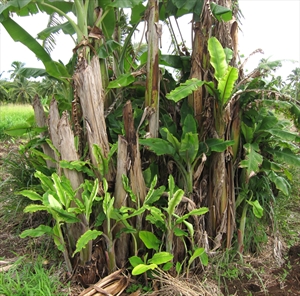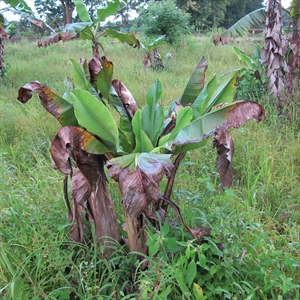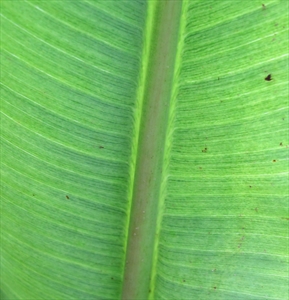Banana bunchy top
Pacific Pests, Pathogens, Weeds & Pesticides - Online edition
Pacific Pests, Pathogens, Weeds & Pesticides
Banana bunchy top (121)
Banana bunchy top nanavirus. There are 2 groups of BBTV isolates from different regions: the South Pacific group (including Australia, Burundi, Egypt, Fiji, India, Tonga, Western Samoa) and the Asian group (including Philippines, Taiwan, Viet Nam). The mean sequence difference between the two groups has been reported as approximately 10 percent. The abbreviation is BBTV.
Asia, Africa, North America (Hawaii), Oceania. It is recorded from American Samoa, Australia (restricted), Fiji, Guam, New Caledonia, Samoa, Tonga, Tuvalu, and Wallis and Futuna.
Banana and others in the genus Musa.
A serious disease of bananas and plantains. Plants with banana bunchy top (BBT) have narrow, progressively shorter leaves with little distance between them, hence the name 'bunchy top' (Photos 1&2). Leaf edges often roll upwards with yellow margins. The most characteristic symptoms are short, dark-green dots and dashes along the minor leaf veins, so-called 'Morse-code' patterns, which form hooks curving downwards near the edge of the midrib (Photo 3). Hold the leaf up to the light and view from the underside.
The virus is spread by an aphid, Pentalonia nigronervosa (Photo 4). It takes more than 4 hours of feeding on a diseased plant before aphids become infected with the virus. But once infected, the aphids continue spreading the virus until they die. Aphids live for 15-20 days. The virus is not transmitted on tools or through the soil (see also Fact Sheet no. 103).
BBT is caused by a virus. In the past, the disease has devastated banana industries in Australia, Fiji, Samoa and Tonga. Today, it is causing much damage in Pakistan and is spreading in the DR Congo. Plants that are infected when young rarely produce a fruit bunch. When diseased suckers are planted they become severely stunted and they do not produce fruit. Plants infected at a later growth stage may produce a distorted bunch. In Pacific island countries, the failure to select healthy planting material has resulted in plantations showing 20% of plants with BBT in the first year, and major losses within 2-3 years.
Look for plants with stunted, short, bunched leaves, with the 'Morse-code' patterns (dot-dash) symptom. Yellowing of the leaf margins also suggests BBT, though this can be caused by other problems. There are commercial ELISA kits to detect the disease. Molecular techniques using PCR (polymerase chain reaction) are more sensitive.
QUARANTINE
Banana plants should only be transferred between countries as tissue cultures tested to ensure that they are free of all known banana diseases. Plants of many varieties of bananas, tested to internationally agreed standards, can be obtained from the INIBAP transit centre in Belgium, and from IITA, Nigeria. The FAO/IBPGR Technical Guidelines for the Safe Movement of Germplasm. No. 15. Musa. 2nd Edition, gives details of the methods to use (http://www.bioversityinternational.org/uploads/tx_news/Musa_spp.__2nd_edition__502.pdf).
NATURAL ENEMIES
In Tonga, Aphidius colemani, a parasitic wasp, was released for biological control of the aphid, but results were disappointing.
CULTURAL CONTROL
Key actions in managing BBT are: (i) the monitoring of banana plantations for BBT symptoms; and (ii) rapid removal of diseased plants. If the disease is found in the field, do the following:
- Before destruction, spray diseased plants with soap, oils, kerosene or insecticide to kill all aphids (see below).
- After killing the aphids, you have three choices:
- Method 1: Within 48 hours, dig out the stool, including the main plants and all suckers. Chop the plants, including the corms, into small pieces. Burn or bury.
- Method 2: Inject the diseased plant with herbicide (e.g., glyphosate, 1 part to 5 parts water). Inspect the plants to make sure they are dead. If not, retreat.
- Method 3: Scoop out the middle of the stem and pour kerosene into the well. Inspect the plants to make sure they are dead. If not, retreat.
RESISTANT VARIETIES
All varieties of banana are susceptible, although some may take longer to develop symptoms. Some varieties may escape infection because they are not as attractive to aphids as other varieties.
CHEMICAL CONTROL
The choice of chemicals for killing aphids on diseased plants, before removal from the soil, depends on whether they are grown for household use or for sale.
- Banana for home use: Use soap solution, white oil (vegetable oil) or horticultural oil (petroleum oil) (see Fact Sheet no. 56). Kerosene can also be used as mentioned above. Aim to spray the 'throat', the V-shaped area where the leaves meet and where aphids hide.
- Commercial plantations: The following have been recommended for Pacific island countries: dimethoate (400 g/L), used at 75 ml/100L; diazinon (200 g/L), used at 1.5 ml/L; acephate (75% WP), used at 1.3 g/L. Note, in Australia, the use of dimethoate is restricted, and the use of the chemical remains under review. Diazinon use is also under review.
- Synthetic pyrethroids are likely to be effective.
____________________
When using a pesticide, always wear protective clothing and follow the instructions on the product label, such as dosage, timing of application, and pre-harvest interval. Recommendations will vary with the crop and system of cultivation. Expert advice on the most appropriate pesticides to use should always be sought from local agricultural authorities.
AUTHOR Grahame Jackson
Information from CABI (2015) Banana bunchy top virus (bunchy top of banana) Crop Protection Compendium. (https://www.cabi.org/cpc/datasheet/8161); and from Banana bunchy top virus (2017) Plant Biosecurity and Product Integrity, Department of Primary Industries. NSW Government, Australia. (https://www.dpi.nsw.gov.au/biosecurity/plant/insect-pests-and-plant-diseases/bunchy-top) and from Bunchy top, banana - Australia (Queensland, New South Wales) Alert. ProMED. (http://www.promedmail.org). Photo 1 Richard Markham. ACIAR, Canberra.
Produced with support from the Australian Centre for International Agricultural Research under project PC/2010/090: Strengthening integrated crop management research in the Pacific Islands in support of sustainable intensification of high-value crop production, implemented by the University of Queensland and the Secretariat of the Pacific Community.







